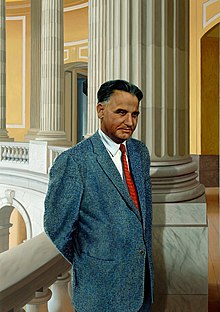Dalip Singh Saund
| Dalip Singh Saund | |
|---|---|

Painting on canvas of Saund
|
|
| Member of the U.S. House of Representatives from California's 29th Congressional district |
|
|
In office January 3, 1957 – January 3, 1963 |
|
| Preceded by | John J. Phillips |
| Succeeded by | George Brown, Jr. |
| Personal details | |
| Born |
September 20, 1899 Chhajulwadi, Punjab, India |
| Died | April 22, 1973 (aged 73) Hollywood, California |
| Nationality | American |
| Political party | Democratic |
| Spouse(s) | Marian Saund |
| Children | Dalip Singh Saund Jr., Julie Saund, Ellie Saund |
| Alma mater | University of California, Berkeley |
| Religion | Sikhism |
Dalip Singh Saund (September 20, 1899 – April 22, 1973) was an American politician who was a member of the United States House of Representatives. He served the 29th District of California from January 3, 1957 to January 3, 1963. He was the first Sikh American, the first Asian American, the first Indian American and the first member of a non-Abrahamic faith to be elected to Congress.
Born in Chhajulwadi, Punjab, India, to a Sikh family, he received his bachelor's degree in mathematics from the University of Punjab in 1919.
He immigrated to the United States (via Ellis Island) originally to study agriculture at the University of California, Berkeley. While at the university, he obtained a master's degree (1922) and a PhD (1924), both in mathematics. He thereafter remained in the United States, becoming a successful farmer.
Later, he campaigned to allow "Hindus", as all people of South Asian descent were called at that time, to become naturalized citizens. After the Luce-Celler Act was passed in 1946, he applied for naturalization and became an American citizen in 1949. He ran for election in 1950 as a Justice of the Peace for Westmoreland township, California, and won the election, but his election was thrown out as he had been a citizen for less than a year. He later ran again for the same post and won.
...
Wikipedia
